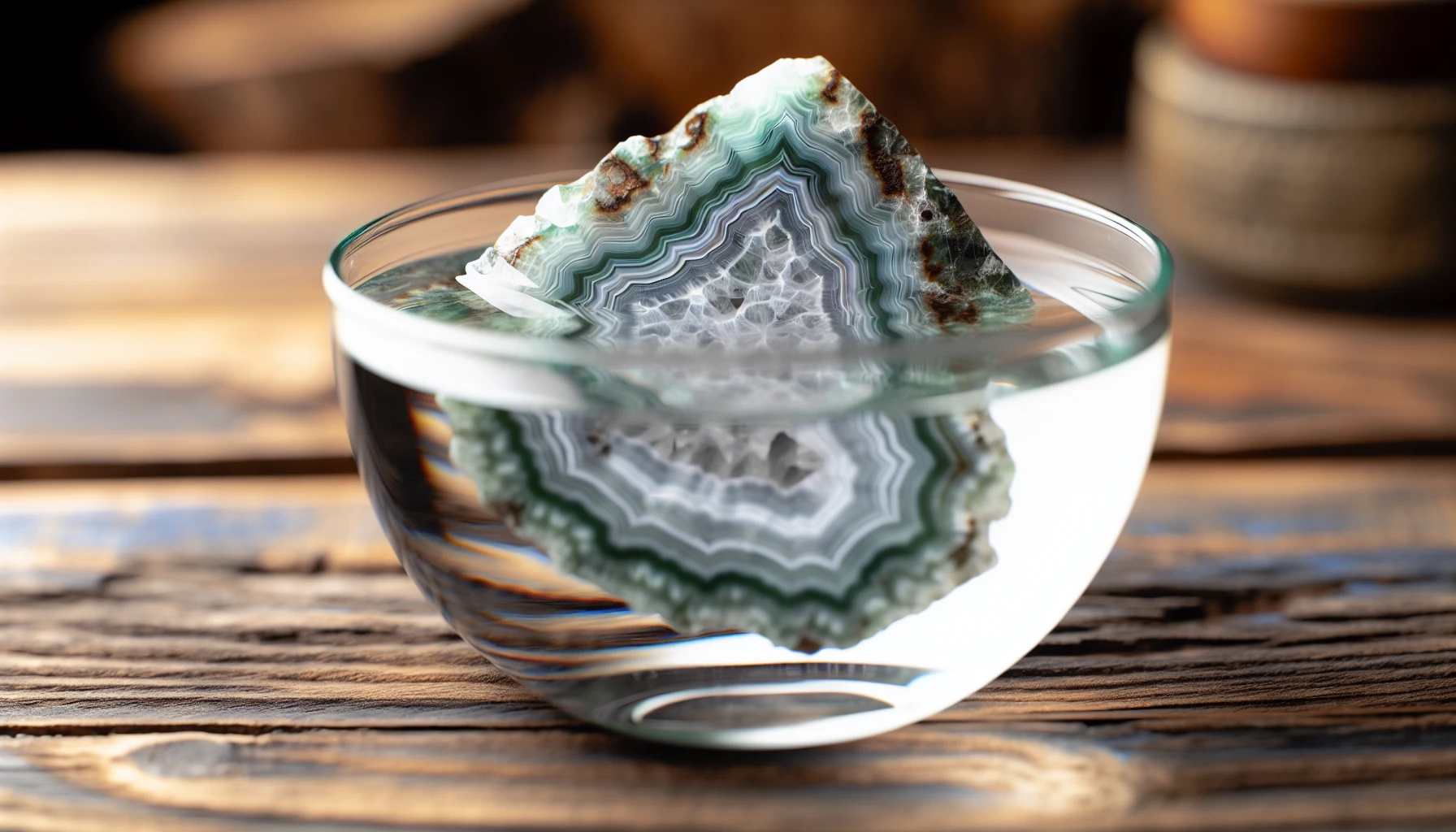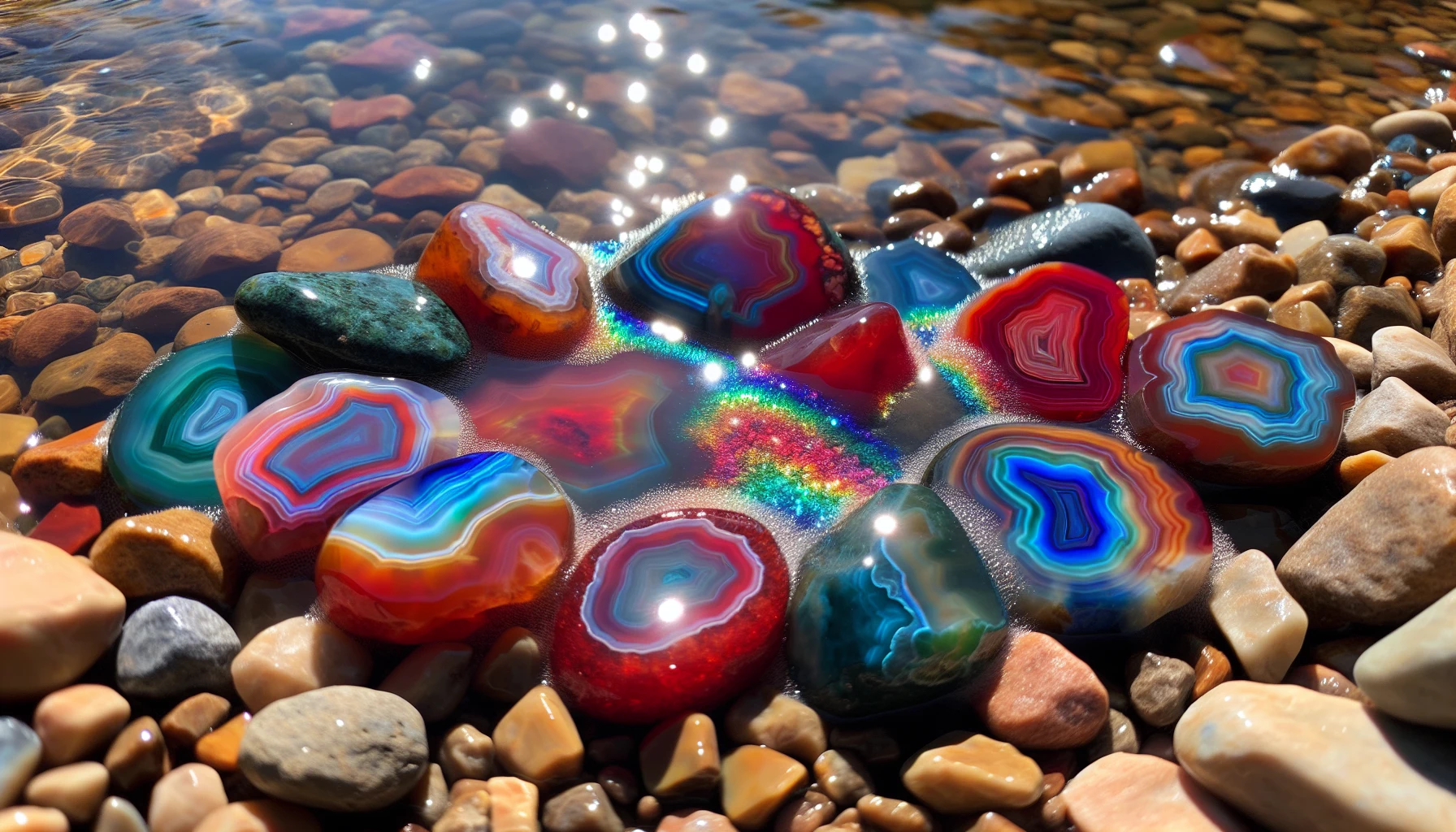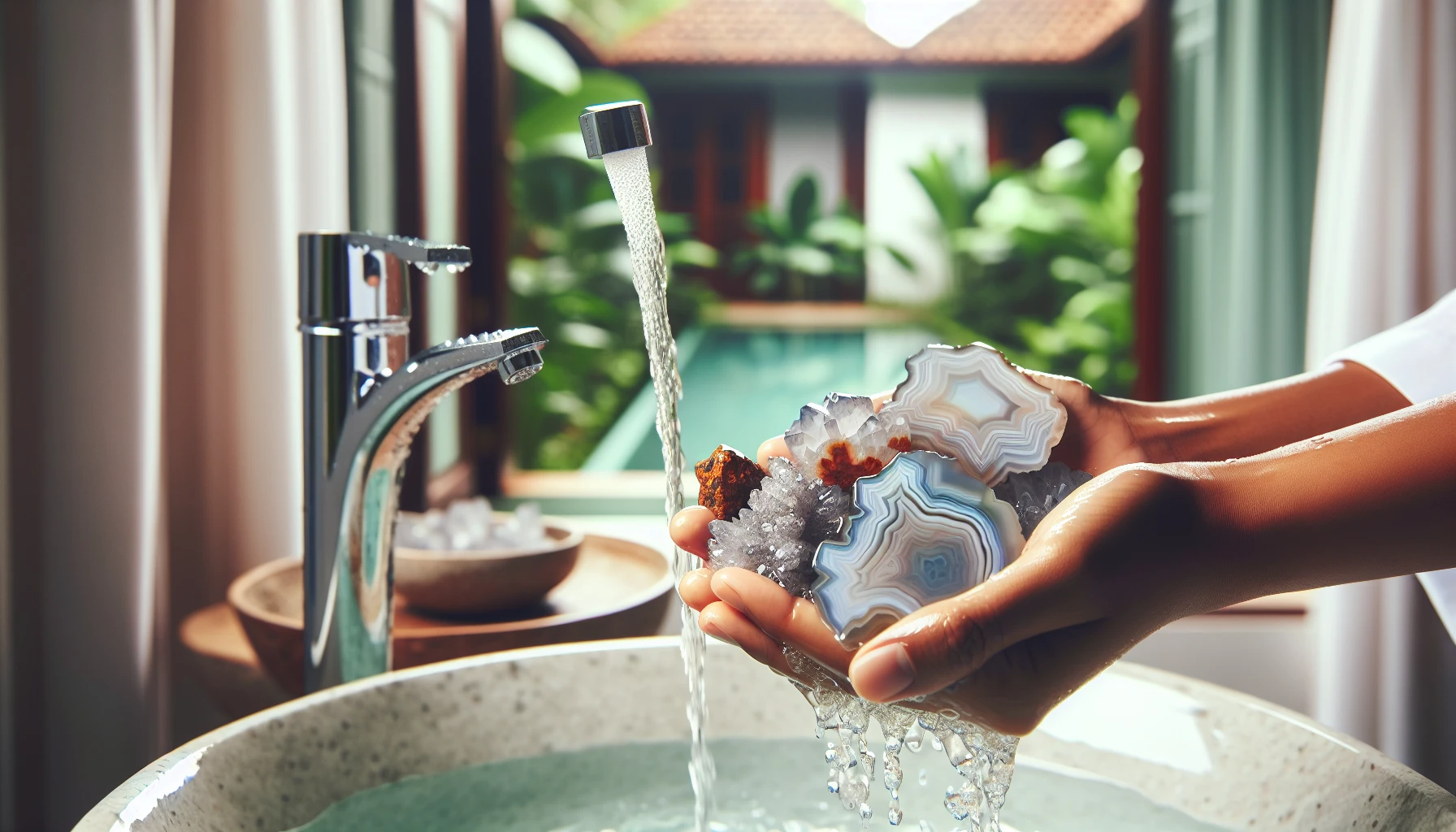Yes, Agate can go in water. Agate has a hardness of 6.5 to 7 on Mohs hardness scale and has low sensitivity to water, making it water safe.
In this blog post, we’ll dive deep into the relationship between Agate and water, discussing everything from the water safety of agate to the best ways to clean and care for your precious crystals. Get ready to become an Agate expert and ensure your stones remain vibrant and powerful for years to come!
Key Takeaways
- Agate is safe when exposed to water, but different types of agates may interact differently with it.
- Tap or saltwater must be avoided for prolonged exposure. Distilled, filtered and rainwater are best for cleaning.
- To keep your agate crystals looking great and preserve their energy properties, use the right storage solutions & handling precautions while regularly cleaning them with lukewarm water.
Is Agate Water Safe?

Agate crystals are generally considered to be water-safe due to their hardness and lack of sensitivity to water. This is because of Agate’s position on the Mohs hardness scale, which measures the hardness of minerals and ranges from 1 to 10, with 10 being the hardest. Agate has a hardness rating of 6.5 to 7, making it a durable and resistant stone, unlikely to be damaged by water. However, the type of water and the duration of exposure should be considered to avoid potential harm to the stone.
Examining how agate reacts with various types of water such as salt water, sunlight exposure, and tap water will provide a deeper understanding.
Can Agate Go In Salt?
Salt water may cause damage to the stone even though dry salt doesn’t pose a risk to agate. Agate is not particularly sensitive to salt water, and its hardness on the Mohs scale allows it to withstand some exposure without damage. However, if salt water seeps into the tiny cracks in the stone, it could cause corrosion and pitting, leading to discoloration and a dull appearance.
Preventing salt water damage to agate is best achieved by using freshwater for cleaning or soaking the stone instead. If you accidentally expose your agate to salt water, rinse it thoroughly with fresh water to remove any salt residue.
Can Agate Be In the Sun?
Agate crystals can tolerate sunlight exposure but exercise caution when you expose Agate in the sun. Prolonged sunlight exposure may cause fading or discoloration due to the effect of UV rays on the stone. To avoid damage, it’s best not to leave agate in direct sunlight for more than three hours.
When storing agate, especially in the form of jewelry, keep it away from direct sunlight to prevent scratching and fading.
Can Agate Go In Tap Water?
Tap water may cause Agate to appear dull and dirty because of its limestone content, but this can be easily removed by wiping the stone gently with distilled water. To clean Agate crystals with tap water, simply rinse them under running water and gently dry them with a soft cloth or towel.
Although tap water is generally safe for Agate crystals, avoiding prolonged exposure and using distilled water when possible is recommended to ensure your stones remain vibrant and free from damage.
Agate and Water: Understanding the Basics
Agate is a type of quartz that forms through a slow process of mineral deposition within cavities of volcanic and plutonic igneous rocks. This process takes thousands of years, with silica-rich groundwater accumulating in the voids of these rocks and eventually forming the beautiful patterns and colors we associate with agate crystals. Agate’s position on the Mohs hardness scale, ranging from 6.5 to 7, makes it generally water-resistant and unlikely to be damaged by water exposure.
A deeper understanding of Agate and its interaction with water can be gained by examining the basics of agate formation and its position on the Mohs hardness scale.
Agate Formation
Agate crystals form through a slow process of mineral deposition in cavities of volcanic rocks, such as basalt. This process involves silica-rich groundwater accumulating in the voids of the rocks, eventually leading to the formation of agate crystals made up of various minerals, including:
- Quartz
- Opal
- Moganite
- Cristobalite
- Calcite
The formation of Agate crystals and Agate stones requires specific geological processes and conditions, with temperatures ranging from 20 to 230 °C.
The slow process of mineral deposition in Agate crystals creates their unique patterns and colors through the formation of oriented intergrowth of quartz grains, giving Agate its fibrous consistency. The various colors and patterns seen in Agate are a result of the different minerals present in the stone, as well as the conditions under which they formed.
Mohs Hardness Scale and Agate
The Mohs hardness scale is used to measure the hardness of minerals on a scale from 1 to 10, with 10 being the hardest mineral (diamond). Agate has a Mohs hardness score of 7, making it a relatively hard gemstone. This high hardness score means that Agate crystals are less likely to be scratched or damaged by water exposure, contributing to their general water resistance and durability.
As a result, Agate crystals can typically withstand water exposure without suffering any harm, but it’s always best to take precautions and avoid prolonged exposure when possible.
Types of Agates and Their Interaction with Water

Although Agate crystals are generally considered water-safe, different types of agates may have varying levels of water tolerance. Some common types of agate include:
- Fortification Agate
- Moss Agate
- Plume Agate
- Tube Agate
- Iris Agate
- Fire Agate
- Eye Agate
These agates may have differing susceptibilities to water exposure, making it essential to understand the specific characteristics of each type.
The water interaction of three popular types of agates: Moss Agate, Blue Lace Agate, and Tree Agate will be examined next.
Can Moss Agate Go In Water?
Yes, Moss Agate can go in water. While Moss Agate can withstand water exposure, it’s always best to minimize its contact with water to preserve the stone’s appearance and energy properties.
Moss Agate is a unique variety of agate that can be safely placed in water, but it’s still best to avoid prolonged exposure. To clean Moss Agate, follow these steps:
- Use lukewarm filtered or distilled water.
- Rinse the stone under running water for a short period of time.
- After cleaning, be sure to dry the stone completely to prevent any water spots or damage.
Can Blue Lace Agate Go In Water?
Yes, Blue Lace Agate, a beautiful and delicate variety of Agate, can go in water. It is safe to use water for cleaning Blue Lace Agate, but always be cautious and gentle to prevent any damage or weakening of the stone.
Blue Lace Agate should not be placed in saltwater as it can damage the stone. To clean Blue Lace Agate, use fresh water and avoid leaving the stone submerged for extended periods of time.
By taking proper care when handling and cleaning Blue Lace Agate, you can ensure its delicate beauty and energy properties remain intact.
Can Tree Agate Go In Water?
Yes, Tree Agate can be safely placed in water without causing harm to the stone. However, it’s still important to avoid prolonged exposure to water to prevent any potential damage or weakening of the stone’s structure.
By taking proper precautions when handling and cleaning Tree Agate, you can maintain its unique appearance and energy properties for years to come.
How to Clean Agate Crystals Safely with Water?
Choosing the right water source and adhering to proper cleansing techniques is necessary for the safe cleaning of Agate crystals and their durability. By doing so, you can keep your Agate crystals looking vibrant and free from damage, while also maintaining their energy properties.
The importance of selecting the correct water source and the best practices for safely cleansing Agate crystals with water will be outlined next.
Choosing the Right Water Source
Using filtered, distilled, or rainwater is recommended for cleaning Agate crystals, as these types of water are free from impurities or minerals that could harm the crystals or leave residue on them. Tap water may contain minerals or chemicals that could damage the crystals, so it’s best to avoid using it for cleaning Agate crystals if possible.
Even though tap water is generally safe for Agate crystals, it’s still important to consider the chemical composition of the water and its potential effects on the stone. If you’re unsure about the quality of your tap water, consider using filtered or distilled water instead to ensure the safety and longevity of your Agate crystals.
The Cleansing Process
To clean Agate crystals safely with water, follow these simple steps: First, gently rinse the crystals under running water, taking care not to scrub too hard or use water that is too hot or cold. After rinsing, use a soft cloth or towel to gently dry the crystals, ensuring that they are completely dry before storing or using them. This method is suitable for cleansing Agate crystals without causing any damage, and it can help maintain their appearance and energy properties for years to come.
It’s essential to handle Agate crystals with care when cleaning them, as rough handling or exposure to harsh chemicals or extreme temperatures can alter their energy properties and cause damage. By following these guidelines and treating your Agate crystals with respect, you can ensure their optimal energy properties and keep them looking beautiful and vibrant.
What are Other Methods for Cleansing and Charging Agate Crystals?

In addition to water cleansing, there are other methods for cleansing and charging Agate crystals that can be just as effective. These alternative methods include smoke cleansing and charging the crystals under moonlight or sunlight. Both of these methods can help to cleanse your Agate crystals of negative energy and recharge them with positive energy, ensuring their healing properties remain strong and vibrant.
Alternative cleansing and charging methods, beginning with the benefits of smoke cleansing for agate crystals, will be examined in greater detail.
Smoke Cleansing
Smoke cleansing is a powerful method for purifying Agate crystals and removing any lingering negative energy. To perform smoke cleansing, simply:
- Light your preferred smudging tool, such as sage or incense.
- Pass the crystal through the smoke for about 30 seconds.
- The smoke’s purifying properties will cleanse the crystal and drive out any negative energy, leaving it refreshed and ready for use.
It’s important to take a few precautions when smoke cleansing Agate crystals:
- Use a fire-safe bowl or plate to hold the burning herbs or incense.
- Stand a safe distance away from the smoke to prevent any respiratory irritation.
- Open windows and doors to allow negative energy to escape during the cleansing process, ensuring a thorough and effective cleansing of your Agate crystals.
Moonlight or Sunlight Charging
Charging Agate crystals under moonlight or sunlight is another effective method for cleansing and recharging their energy properties. To charge your Agate crystals in this way, simply place them under direct moonlight or sunlight for a few hours. The natural energy from the moon or sun will energize and recharge the crystals, enhancing their energy properties and preparing them for use in healing or meditation.
However, be cautious with sunlight exposure, as it can damage certain crystals and precious stones, making moonlight charging a safer option for some stones.
Potential Risks of Water Exposure for Agate
Despite agate crystals being generally safe in water, potential risks related to water exposure need to be considered. These risks include damage to the stone, discoloration of the crystal, and potential impacts on the crystal’s energy properties. By understanding these risks and taking the necessary precautions, you can ensure the safety and longevity of your agate crystals.
These potential risks, starting with the possibility of water damage to Agate crystals, will be examined in greater detail.
Water Damage
Prolonged water exposure may cause damage to Agate crystals, as water molecules can seep into the stone’s small cracks and cause them to widen or even break the stone. Although Agate has a high hardness rating on the Mohs scale, which makes it unlikely to be damaged by water, taking precautions and avoiding prolonged exposure is still important to prevent any potential harm to the stone.
To minimize the risk of water damage, it’s best to clean Agate crystals with fresh water and avoid leaving them submerged for extended periods of time. Additionally, when storing Agate crystals, keeping them in a cool, dry place away from direct sunlight and moisture can further protect them from potential water damage.
Discoloration
Water exposure may also cause Agate crystals to lose their color or luster, as water can react with the minerals and impurities embedded in the stone, leading to changes in color and appearance. To avoid discoloration, it’s important to limit the exposure of Agate crystals to water, especially for those with vibrant colors or patterns.
In cases where discoloration occurs, it may be possible to reverse or prevent it by avoiding the factors that caused the change, such as exposure to chemicals like iron oxide or sunlight.
Energy Impact
While water exposure may not directly affect the energy properties of Agate crystals, it’s essential to consider the potential indirect impacts that water may have on the stone’s vibrational properties. For example, water damage or discoloration could alter the crystal’s energy properties, affecting its ability to provide healing benefits or maintain its energetic balance.
As a result, it’s always best to handle Agate crystals with care and avoid prolonged exposure to water when possible to maintain their optimal energy properties.
Tips for Caring for Your Agate Crystals
Maintaining the appearance, energy properties, and overall longevity of your Agate crystals requires proper care. By following appropriate storage practices, regularly cleaning your crystals, and handling them with care, you can ensure your Agate crystals remain vibrant and powerful for years to come.
Practical tips and guidelines for storing, cleaning, and handling your Agate crystals will be discussed next. This will ensure they remain in excellent condition and continue to provide their healing benefits.
Storage Solutions
Proper storage is crucial for maintaining the appearance and energy properties of your Agate crystals. Store your Agate crystals in a cool, dry place away from direct sunlight and moisture to prevent damage or discoloration. Suitable storage options include natural fabric-lined wooden boxes or chests, organza bags, velvet pouches, or even plastic or glass containers.
By storing your Agate crystals in a safe and protected environment, you can ensure they remain in optimal condition and maintain their healing properties.
Regular Cleaning
Clean your Agate crystals regularly to maintain their appearance and energy properties. It’s recommended to clean your Agate crystals at least once a month, or more frequently if you feel they’ve been exposed to negative energy.
To clean your Agate crystals:
- Use lukewarm water.
- Use a soft brush or cloth to gently clean the crystals.
- Avoid using harsh chemicals or abrasive materials that could scratch or damage the stone.
By keeping your Agate crystals clean and free from negative energy through the use of cleansing crystals, you can ensure they continue to provide their healing benefits and maintain their vibrant appearance.
Handling Precautions
Handle your Agate crystals with care to avoid damage and maintain their energy properties. When handling Agate crystals, be sure to:
- Wear a head covering, apron, and/or coveralls to protect yourself from rock dust
- Wash your hands after handling the crystals to prevent the spread of dust
- Wear rubber latex or nitrile gloves to protect your skin from irritations
- Avoid eating or drinking while handling Agate crystals
By taking these precautions and treating your Agate crystals with respect, you can maintain their optimal energy properties and keep them looking beautiful and vibrant.
Summary
In conclusion, understanding the relationship between Agate and water is essential for ensuring the longevity and vibrancy of these beautiful stones. Agate crystals are generally water-safe due to their hardness and lack of sensitivity to water, but it’s always best to take precautions and avoid prolonged exposure when possible. By following proper storage, cleaning, and handling practices, you can ensure your Agate crystals remain in top condition, providing their healing benefits for years to come. So go ahead and enjoy the beauty and energy of your Agate crystals, knowing that with proper care, they’ll continue to shine brightly and powerfully.
Frequently Asked Questions About Agate In Water
Can Agate be worn everyday?
Moss Agate is a strong and durable gemstone, making it an ideal choice for daily wear. Its hardness on the Mohs scale is 7 and is not affected by lighting conditions or water, meaning you can confidently wear your moss agate promise ring everyday. It also makes an excellent engagement ring, so if you plan to be active with it, consider a design that uses metal or other gems to protect its edges.
Can Agate go in the sun?
Yes, Moss Agate can go in the sun but should not be kept there for too long.
Is Moss Agate safe in water?
Moss Agate is safe to clean with soapy water and should be completely dried after for best results.
Is flower Agate safe in water?
Flower Agate is safe to cleanse with water, however be sure to do some research on other crystals before doing so.
Is it safe to use tap water for cleaning Agate crystals?
It’s best to use filtered or distilled water when cleaning Agate crystals to avoid any potential damage or residue, but tap water is generally safe.